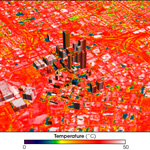Urban Heat Island Effect
f) Mitigation at Local/Regional/National Level

Urban heat island mitigation began indirectly with the green movement of the 1970’s. During that time oil prices were increasing and the effects of an industrialized lifestyle was becoming visible through air, water and soil contamination. There was a strong political and social movement to improve energy efficiency and begin research on alternative energy sources. Green buildings, improving building efficiency and eco-friendly construction practices can be traced to the environmental movement.
Since the 1970’s there has been gradual progress in green building programs and material development. A few early examples are:
- 1989: the American Institute of Architects (AIA) formed the “Committee on the Environment"
- 1992: the Environmental Resource Guide was published by the AIA and funded by the EPA
- 1992: EPA and DOE launched the ENERGY START program
- 1992: the first green building program was introduced in Austin, TX
- 1993: the U.S. Green Building Council (USGBC) was founded
- 1993: the Clinton Administration launched the “Greening of the White House” initiative
- 1998: the USGBC launched the Leadership in Energy and Environmental Design (LEED) pilot program (USEPA, 2011)
Over forty years later the green movement, with respect to green buildings, is still evolving. Programs like ENERGY STAR and LEED are accelerating new approaches helping consumers and contractors alike to build green.
Section a) Introduction (HOME)
Section b) Why is Urban Heat Island a concern?
Section c) How Climate Change will affect UHI
Section d) Measuring the Urban Heat Island Effect
Section e) How can Urban Heat Island be Remediated?
Section f) Mitigation at Local/Regional/National Level
(By Kiersten Lee/Gregory Möller)

